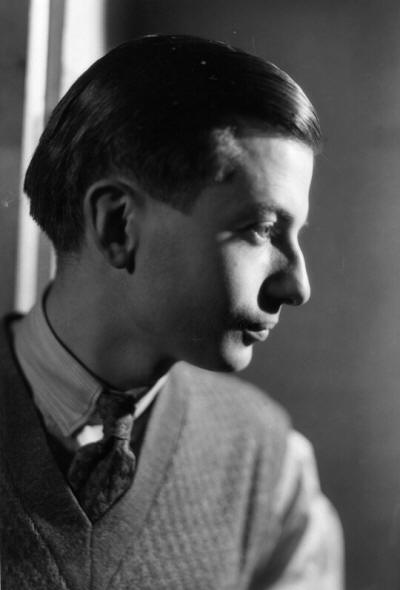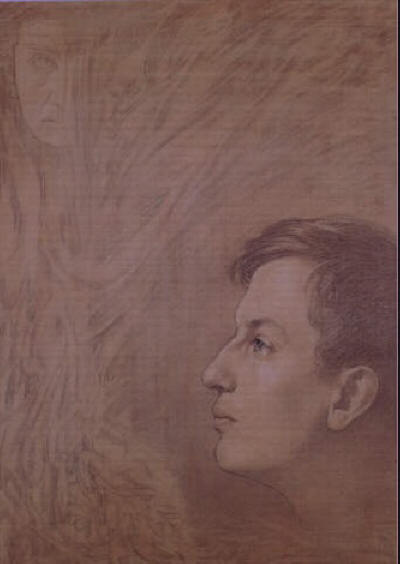Partner Max Chapman
Queer Places:
Fradgan Studios, The Fradgan, Newlyn, Penzance TR18, UK
The Lobster Pot, S Cliff, Mousehole, Penzance TR19 6PG, UK
 Oswell Blakeston was the pseudonym of Henry Joseph Hasslacher (May
17, 1907 – June 4, 1985), a British writer and artist who also worked in the film industry, made some experimental films, and wrote extensively on film theory. He was also a poet and wrote in non-fiction areas including travel, cooking and pets. His pseudonym combined a reference to the writer
Osbert Sitwell with his mother's maiden name.[1] Blakeston lived in Mousehole with the painter
Max Chapman and was a friend of
Mary Butts's from 1931 onwards and admirer of her work.
Max Chapman run a guest - house at Mousehole called the Lobster Pot. A newly
wed Dylan Thomas stayed there. According to Blakeston and Chapman, Thomas
dabbed in gay behaviour. Such stories, circulating in private, have been
decried by others, who were friends of Thomas at the time. Neither Blakeston
nor Chapman made extensive claims. Max Chapman and Oswell Blakeston formed an
extraordinary and prolific couple, whose lives and achievements are little
documented. They first met in the late 1920s or early 1930s, and remained
together thereafter.
Oswell Blakeston was the pseudonym of Henry Joseph Hasslacher (May
17, 1907 – June 4, 1985), a British writer and artist who also worked in the film industry, made some experimental films, and wrote extensively on film theory. He was also a poet and wrote in non-fiction areas including travel, cooking and pets. His pseudonym combined a reference to the writer
Osbert Sitwell with his mother's maiden name.[1] Blakeston lived in Mousehole with the painter
Max Chapman and was a friend of
Mary Butts's from 1931 onwards and admirer of her work.
Max Chapman run a guest - house at Mousehole called the Lobster Pot. A newly
wed Dylan Thomas stayed there. According to Blakeston and Chapman, Thomas
dabbed in gay behaviour. Such stories, circulating in private, have been
decried by others, who were friends of Thomas at the time. Neither Blakeston
nor Chapman made extensive claims. Max Chapman and Oswell Blakeston formed an
extraordinary and prolific couple, whose lives and achievements are little
documented. They first met in the late 1920s or early 1930s, and remained
together thereafter.
Blakeston was born to a family of Austrian origin. At age 16 he ran away, becoming a conjuror’s assistant, a cinema organist and studio clapperboy.[2]
Blakeston joined the staff of Close Up, the magazine of the Pool Group, in August 1927. While at Close Up, he very much became a protégé of
Kenneth Macpherson, the publication’s editor, and contributed more articles than any other single writer—a total of 84; he contributed to all but four of the journal's issues. While writing for Close Up, he worked in a variety of capacities in the British film industry and was for a time an assistant cameraman at Gaumont Studios.[3]
In 1930, he made the short abstract film Light Rhythms with
Francis Bruguière, long thought to be lost but which is now recovered.
He then edited the little magazine Seed with Herbert Jones, and wrote detective fiction with Roger Burford, under the pseudonym 'Simon'. From 1929, he also published novels and stories under the Blakeston name, producing 15 books of fiction, as well as 10 collections of poetry. The novels are wide-ranging, and include a number of works that mix gay themes with suspense and detective plots.
Blakeston was a contributor to John Gawsworth's anthologies, and a collaborator of M. P. Shiel. He also authored a number of travel books. According to the obituary of his partner
Max Chapman, Blakeston achieved a number of firsts: his book Magic Aftermath (1932) was "the first fiction to be published in spiral binding" and his 1935 crime story The Cat with the Moustache (a collaboration with Burford) was "one of the first descriptions of trips with mescal". In his 1938 anthology Proems, Blakeston "published the first poems by
Lawrence Durrell".[1]



Austin Osman Spare (British, 1888–1956), Title:
Portrait of Oswell Blakeston - Metamorphosis , 1933, Medium:
Pencil and Watercolor,
Size:
38.8 x 27.9 cm. (15.3 x 11 in.)
Chapman meanwhile worked as a painter, art critic, and occasionally
illustrated Blakeston’s poetry. He was born in Dulwich, and from the age of 16
attended Byam Shaw School of Art, where one of his teachers was
Charles Ricketts, with whom he
established a friendship. Ricketts lived at Regent’s Park with his companion,
fellow artist Charles
Shannon. The pair had been part of the fin de siècle circle of
Oscar Wilde and
Aubrey Beardsley – Ricketts
illustrated a number of Wilde’s books – and had also known
Walter Sickert, Bernard Shaw,
and Sergei Diaghilev.
For Chapman, unapologetically certain of his homosexuality from a young
age, friendship with Ricketts surely served as affirmation of his own
proclivities. Upon leaving art school in 1930 Chapman went first on a
scholarship to Italy, before then buying studio premises at Newlyn in
Cornwall, previously used by the painters Dod and Ernest Procter. There he
began his artistic career, producing figurative paintings influenced by
Post-Impressionism and Matisse.
Chapman and Blakeston lived together in Mousehole, becoming fixtures of the
Cornish artistic scene: both were drawn by Sven Berlin (Blakeston in 1939;
Chapman in 1941) as part of a set of portraits entitled St Ives Personalities,
whose subjects also included Barbara Hepworth and Bernard Leach amongst others
(the set is now in a private collection).
After a first one-man show in London in 1939, Chapman went on to exhibit
widely in the UK and Europe. By the late 1950s, now living with Blakeston in
London, he was making abstracts. The trigger for this stylistic change came
upon seeing Jackson Pollock’s work: most probably at the 1958 Pollock
retrospective at The Whitechapel Gallery. Amongst Chapman’s various
explorations in abstraction was a technique he christened collages noyée, or
‘drowned stick-ons’, which involved the manipulation of collaged papers into a
form of low relief, which were then unified beneath a skin of paint. He also
explored combinations of water and oil based paints to achieve particular
effects, as can be seen in three 1960s canvases here: Emersion to Brown,
Chinese, and Wings. In each, water-based emulsion has been floated over oil
paint, with glazes of oil later applied over areas of mottled dried emulsion.
With their amorphous shapes and smoky diffusions of tonal colour, these
immensely subtle paintings evoke elemental flux.
In the 1950s Blakeston was a contributor to ArtReview, then titled Art News and Review.[4]
Blakeston's work was produced for small presses and specialty publishers and is no longer in print. The Harry Ransom Center at the University of Texas at Austin is home to an archive of Blakeston materials available to researchers.[5]
Many of Blakeston's books are dedicated to his longtime partner, the artist
Max Chapman, who also provided illustrations or photographs for a number of the volumes.
Later still Chapman resumed figurative painting, and in 1976 exhibited a
series of portraits at the Camden Art Centre. His subjects included Blakeston
and the actress Rosalinde Fuller (1975). Painted with the sensitive economy of
Chapman’s abstracts, the portrait is made from a black and white photograph of
Fuller, likely to have been taken by Blakeston’s friend
Francis Bruguière in the late
1920s. (A group of Bruguière’s black and white photographs of Fuller were
donated to the National Portrait Gallery by Blakeston in 1983.)
Though Blakeston’s Adolescence (1982) might be said to have something of
the formal invention of his partner’s abstracts, it is perhaps unsurprisingly
a more literary painting, stylistically closer to Pop. Blakeston was an artist with a "quick eye for the bizarre and the outrageous” according to
Max Chapman.[1] His art mixed abstract and expressionist imagery and tended to be small scale. Blakeston had over 40 solo shows, including in London at New Vision Centre, Drian and Grabowski galleries, and some 100 mixed shows at others such as the Leicester, Madden and Mercury galleries. In 1981 he shared an exhibition at Middlesbrough Art Gallery with Max Chapman and after his death, a memorial show was held in 1986 at Camden Arts Centre. Blakeston's work can be found in public collections including the Victoria & Albert Museum, Middlesbrough Institute of Modern Art and the Ulster Museum in Belfast, as well as national galleries in Finland, Poland and Portugal.[2][6]
Blakeston died in 1985. Chapman continued to paint until late on in life,
and died 14 years later.
My published books:


BACK TO HOME PAGE

-
Oswell Blakeston
- Wikipedia
-
https://artuk.org/discover/stories/max-chapman-and-oswell-blakeston-the-life-of-an-artistic-couple
- Dylan Thomas (Literary Biographies)
By Paul Ferris · 1985
 Oswell Blakeston was the pseudonym of Henry Joseph Hasslacher (May
17, 1907 – June 4, 1985), a British writer and artist who also worked in the film industry, made some experimental films, and wrote extensively on film theory. He was also a poet and wrote in non-fiction areas including travel, cooking and pets. His pseudonym combined a reference to the writer
Osbert Sitwell with his mother's maiden name.[1] Blakeston lived in Mousehole with the painter
Max Chapman and was a friend of
Mary Butts's from 1931 onwards and admirer of her work.
Max Chapman run a guest - house at Mousehole called the Lobster Pot. A newly
wed Dylan Thomas stayed there. According to Blakeston and Chapman, Thomas
dabbed in gay behaviour. Such stories, circulating in private, have been
decried by others, who were friends of Thomas at the time. Neither Blakeston
nor Chapman made extensive claims. Max Chapman and Oswell Blakeston formed an
extraordinary and prolific couple, whose lives and achievements are little
documented. They first met in the late 1920s or early 1930s, and remained
together thereafter.
Oswell Blakeston was the pseudonym of Henry Joseph Hasslacher (May
17, 1907 – June 4, 1985), a British writer and artist who also worked in the film industry, made some experimental films, and wrote extensively on film theory. He was also a poet and wrote in non-fiction areas including travel, cooking and pets. His pseudonym combined a reference to the writer
Osbert Sitwell with his mother's maiden name.[1] Blakeston lived in Mousehole with the painter
Max Chapman and was a friend of
Mary Butts's from 1931 onwards and admirer of her work.
Max Chapman run a guest - house at Mousehole called the Lobster Pot. A newly
wed Dylan Thomas stayed there. According to Blakeston and Chapman, Thomas
dabbed in gay behaviour. Such stories, circulating in private, have been
decried by others, who were friends of Thomas at the time. Neither Blakeston
nor Chapman made extensive claims. Max Chapman and Oswell Blakeston formed an
extraordinary and prolific couple, whose lives and achievements are little
documented. They first met in the late 1920s or early 1930s, and remained
together thereafter.



